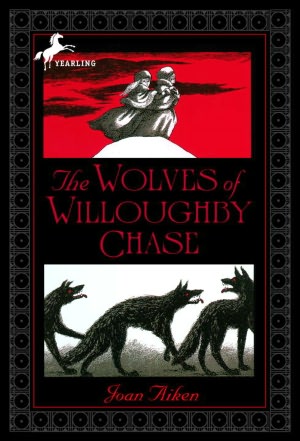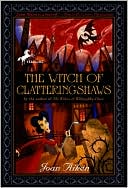Wolves of Willoughby Chase by Joan Aiken 192pp RL 4
The Wolves of Willoughby Chase by Joan Aiken is the first book in her brilliant twelve book series, The Wolves Chronicles. Begun in 1962, the last book in the series, The Witch of Clatteringshaws, was published in 2005, a year after Aiken's death at the age of eighty. With apologies to her readers for writing a rather short book, Aiken said, "better short than unfinished." Her words couldn't be more true. After fantasy, my favorite genre of writing is historical fiction. Amazingly, over the course of the twelve books, The Wolves Chronicles manages to be a delicious blend of the two. Although I read this entire series as an adult, and I am sure that has colored my enthusiasm for it a bit, it has stuck with me for the past 15+ years and remained, in my mind, one of the best written, most imaginatively elegant works for children I have ever read.
Before I being my review, a brief history lesson for those of us not familiar with the lineage of the British Monarchy is necessary to understand the alternative history that The Wolves Chronicles. The House of Stuart was founded by Robert II of Scotland and in the late 14th century. At their height, they ruled over Scotland, England, Ireland and laid claim to the Kingdom of France. The line ended with the death of Queen Anne in 1707 who, as they say, died without issue. The monarchy then passed into the hands of the House of Hanover, a Germanic royal dynasty. The House of Hanover ended in 1901 with the death of Queen Victoria and is, thus far, the longest ruling house in England. In Aiken's world, it is approximately 1830 when The Wolves of Willoughby Chase begins and the House of Stuart is still in possession of the monarchy. The Hanoverians and Burgundians are both plotting to overthrow Good King James III and put an end to his reign. Political intrigue and missing princes are always part of the plot in this series, so a tiny bit of historical knowledge goes a long way to making sense of the characters and their actions. Because of this, it is important to point out to any young reader embarking on this series that Aiken has written a work of fiction in which the timeline of history is similar to the one we know but not real. In spite this, any lack of this knowledge does not detract in any way from enjoyment of the series and might make for a little gasp of surprise when, many years later while studying European history in high school or college, the reader realizes that Aiken made it all up!
The Wolves of Willoughby Chase is set in an England in which a large number of wolves have migrated from the bitter cold of Europe and Russia into Britain via the Channel Tunnel and are terrorizing the citizens of the country, especially in the north where this book is set. With its cast of characters ranging from spinster aunts, orphans, wicked governesses, and embezzlers, all of whom have names that are perfectly suited to their characters, as well as a girls' school that is more like a work house and an enormous estate with hidden passages, this book brings to mind Charles Dickens with a touch of the Brontës thrown in for good measure. When the story opens we find Bonnie Green anxiously awaiting the arrival of her orphaned cousin, Sylvia, who is to be her companion while her parents take a trip that will hopefully restore the health of Bonnie's ailing mother. In their absence, a governess has been hired to teach the girls and oversee the estate. However, Miss Slighcarp turns out to be both cruel and devious, but none of this is noticed in the bustle of the departure of Bonnie's parents. From the moment she is in charge, it is clear that Miss Slighcarp's intentions are to line her own pockets without a thought for anyone else. As life at Willoughby Chase deteriorates, Bonnie and Sylvia find ways to manage. Although all of the upstanding servants have been dismissed so as not to tip of the law, Bonnie's nurse Pattern has remained on, hidden in the house, to do what she can to protect the girls. Another loyal servant, James, has stayed on as well, pretending to be unsavory so that Slighcarp will not suspect him of aiding the children. When Bonnie writes a letter for help that falls into the wrong hands, she and Sylvia are taken immediately, in the dead of a chilling winter night, to the city of Blastburn where Miss Slighcarp's friend, Gertrude Brisket runs a school for girls. Along the way, Miss Slighcarp informs them that the Thessaly, the ship Sir Willoughby and her wife were traveling on, has sunk in a storm.
The Wolves of Willoughby Chase is set in an England in which a large number of wolves have migrated from the bitter cold of Europe and Russia into Britain via the Channel Tunnel and are terrorizing the citizens of the country, especially in the north where this book is set. With its cast of characters ranging from spinster aunts, orphans, wicked governesses, and embezzlers, all of whom have names that are perfectly suited to their characters, as well as a girls' school that is more like a work house and an enormous estate with hidden passages, this book brings to mind Charles Dickens with a touch of the Brontës thrown in for good measure. When the story opens we find Bonnie Green anxiously awaiting the arrival of her orphaned cousin, Sylvia, who is to be her companion while her parents take a trip that will hopefully restore the health of Bonnie's ailing mother. In their absence, a governess has been hired to teach the girls and oversee the estate. However, Miss Slighcarp turns out to be both cruel and devious, but none of this is noticed in the bustle of the departure of Bonnie's parents. From the moment she is in charge, it is clear that Miss Slighcarp's intentions are to line her own pockets without a thought for anyone else. As life at Willoughby Chase deteriorates, Bonnie and Sylvia find ways to manage. Although all of the upstanding servants have been dismissed so as not to tip of the law, Bonnie's nurse Pattern has remained on, hidden in the house, to do what she can to protect the girls. Another loyal servant, James, has stayed on as well, pretending to be unsavory so that Slighcarp will not suspect him of aiding the children. When Bonnie writes a letter for help that falls into the wrong hands, she and Sylvia are taken immediately, in the dead of a chilling winter night, to the city of Blastburn where Miss Slighcarp's friend, Gertrude Brisket runs a school for girls. Along the way, Miss Slighcarp informs them that the Thessaly, the ship Sir Willoughby and her wife were traveling on, has sunk in a storm.
Once there, the girls are issued brown overalls and have their hair chopped off. They are punished immediately and set to work mending and sorting bristles for broom making with little time to plot their escape. When Bonnie, as further punishment, is given the task of tending to the outside work, she encounters an old friend from Willoughby Chase. Simon, slightly older than Bonnie, is an orphan who took up residence, after obtaining Sir Willouhgby's permission, in a cave on the grounds of the Chase some five years back. He had run away from a job on a farm where he was beaten and walked across half of England to get away from him. Sir Willoughby offered to employ Simon as a garden boy, but Simon said he'd rather live off the chestnuts and the goose and gander chicks he had brought with him. In no time, he was raising geese, selling their eggs and driving his flock to London every spring to sell them at the Easter Fair, where they were in high demand. Simon, with boy's clothing, a donkey cart and a few guineas, all provided by Pattern and James, rescues the girls and they set off for London in search of a Mr Gripe, Sir Willoughby's lawyer, a journey which takes them two months. During this time, Simon learns how to read and paint, making use of Bonnie's books and paint box (among the few personal items Miss Slighcarp did not sell off) sent along in the wagon by Pattern to entertain the children on their trip. Simon's talent is so great that he sells many of his paintings and even earns room and board for the group when he repaints the sign of a village inn. Once in London the three children are about to visit Mr Gripe when they see mr Grimshaw, Miss Slighcarp's apprentice, entering his office. Unsure of what this could mean, the go to visit Aunt Jane and find her at death's door. The good Dr Field, a new resident in her building and also a painter, is summoned and begins nursing her back to health as well as earning the trust of the children. After capturing Mr Grimshaw trying to break into Aunt janes rooms at three in the morning, the Bow Street officers are called upon and the story is unravelled. The group, along with the officers, returns to Willoughby Chase by train and sets a trap for Miss Slighcarp, who has turned the house into a school for girls along with Mrs Brisket. Insisting she is acting with Sir Willoughby's permission up to the end, they are locked in the cellar of the house and a celebration is had, one that is enhanced by the return of Sir Willoughby and his wife, who survived the shipwreck and had her health restored by the oranges, grapes, sun, sardines and olive oil that made up her diet on the Canary Islands where they were stranded for three months. Sir Willoughby offers to adopt Simon and send him to school, but Simon says that Dr Field thinks he has promise as a painter and has offered to house him while he attends the best art school in London - which is where we find him at the start of the second book in the series, Black Hearts in Battersea.
While we don't see Bonnie, Sylvia or any of the other characters from The Wolves of Willoughby Chase again (except for a surprise visit from Miss Slighcarp in the third book, Nightbirds in Nantucket) the rest of the series continues with Simon and one of the greatest girl characters ever written in children's literature - Dido Twite (rhymes with died o' fright...) Aiken has great fun with her alternate history and is such an engrossing storyteller that it doesn't matter how much the reader knows about the actual history of England and it's Kings and Queens. Best of all, there is an edition of this series with cover art by Edward Gorey that perfectly suits the stories inside.
The Whispering Mountain, written in 1968 and winner of Guardian Award for Children's Fiction, is considered a prequel of sort to The Wolves Chronicles. Set in Wales, Owen Hughes, son of Captain Hughes of the Thrush, a ship which returns Dido Twite to England by way of a few South American stops, finds himself in a web of mystery surronding the Harp of Teirtu and the many people, both good and bad, trying to get their hands on it. This book can easily be read as a stand alone.
















